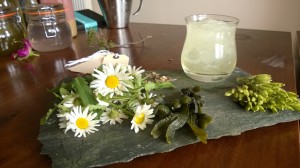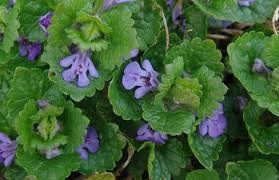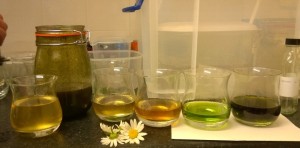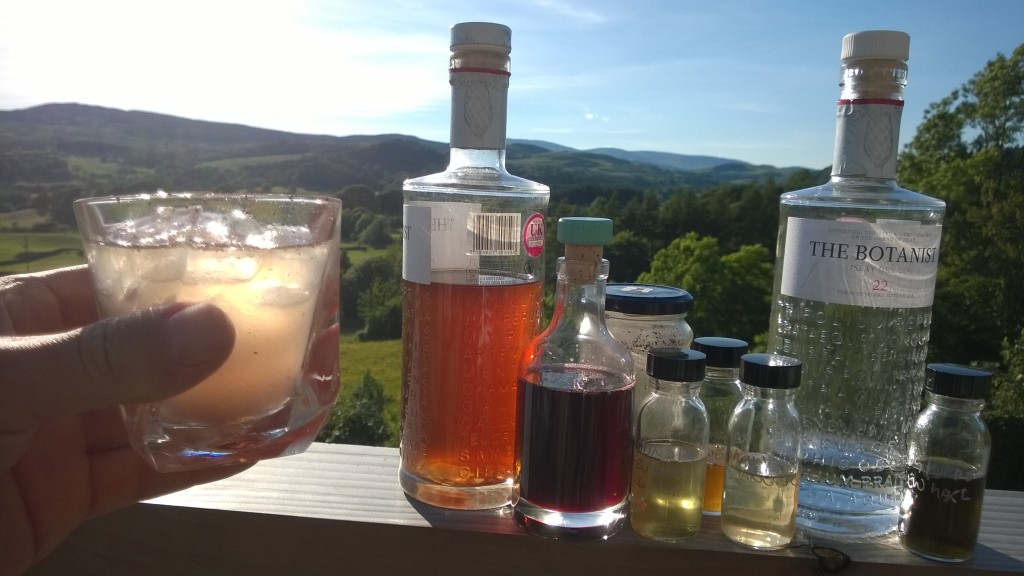Foraged Cocktail Recipe: Islay Spring
Really, such a delicious cocktail should have a more intriguing name. But when we tasted this, after 3 days foraging Islay in beautiful sunshine for the ingredients, its crisp aromatics just sung of the islands woods, marshes, hedgerows, moors and coast. Its one of the nicest things i’ve ever tasted and i’m indebted to drinks alchemist Danny Whelan of Hawthorn Drinks for putting it together as the culmination of our work together on the island. I showed him amazing ingredients – he did very tasty things with them. The perfect symbiosis! You can read more about its birth here.
I make no apologies for the complexity of this recipe (I count around 13 foraged ingredients, 35 if you include the ones in the gin). Its worth the effort. Most of the separate ingredients can be made gradually over time. And even if you don’t get to the same finished drink, I hope some of the processes, like making shrubs and aromatised wine will be fun and make you feel like a child playing in a chemisty lab. This drink proves that the best things in life are free, and that you still need to work a bit to get them…
In the highly unlikely event that you don’t adore the taste of the finished product, you can still enjoy the notion that every sip contains 35 wild ingredients! As my friend Dan says, “Drink with the head, not the mouth!”
Islay Spring
1. Make japanese knotweed and sweet cicely vodka (optional)
This needs to be done well in advance, to allow the plants to infuse. It is only a small part of the final drink, so you might want to cheat and use a little of another fruity vodka (eg. gooseberries or rhubarb, both decent enough substitutes for knotweed), with maybe some fennel seeds, or leave it out altogether.
To make, fill a jar 1/3 with chopped young japanese knotweed shoots. Fill to half way with chopped sweet cicely seeds, leaves, stems. Top up with vodka and leave for at least 2 months, agitating daily for the first 2 weeks. You can add sugar at the start of the process, but, as with sloe gin, I think its best added to taste after maceration is complete. This also allows you to keep some unsweetened for when sourness is called for in cocktails. Knotweed and sweet cicely vodka makes a great drink in its own right, and an invaluable addition to your cocktail armoury.
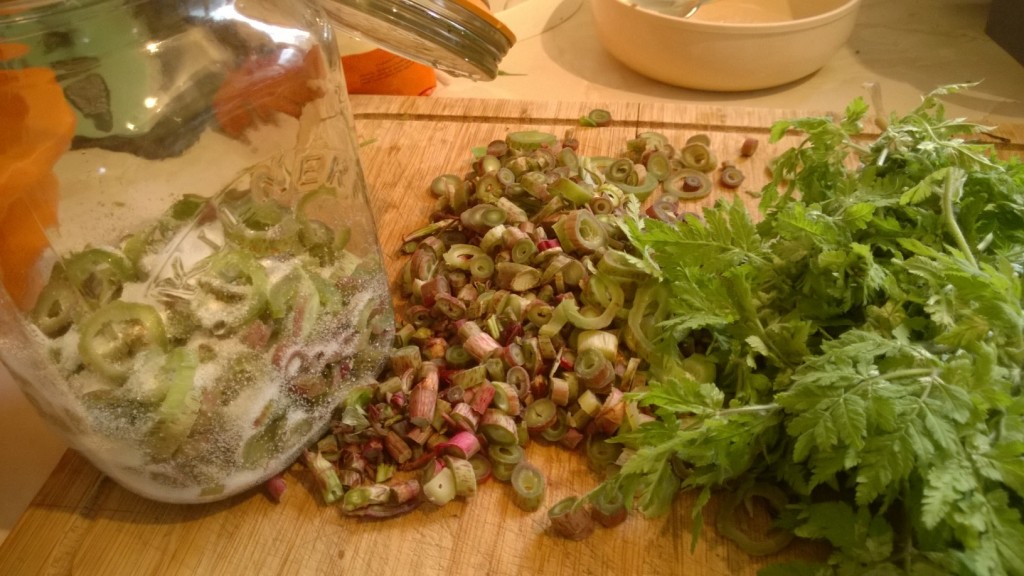
Making japanese knotweed and sweet cicely vodka. These 2 ingredients combine exceptionally well – try them in ice cream, jams, fools, cumbles too
2. Make wild amaro
(For an in-depth dive into making foraged vermouth and amaro, see here)
Amaro refers to a bitter-sweet class of Italian aperativo that can be spirit or wine based. In this instance it is more like a vermouth, only without the wormwood. Bitter, yet aromatic flavours should be to the fore. We used a decent handful of each of the following :
- Bog myrtle leaves (myrica gale)
- Wood sage leaves (teucrium scorodonia)*
- Angelica root (angelica sylvestris)- washed and finely sliced
- Burdock root – washed and finely sliced
- Sorrel leaves
- Yarrow
* Wood sage contains thujone which should only be consumed in small doses. I don’t use more than 2 teaspoons in a 75cl bottle of finished amaro.
Macerate bog myrtle, wood sage and angelica, in separate jars, in the strongest, flavourless spirit you can get hold of – usually vodka. 40% ABV will do, but stronger is better. We used Bruichladdich’s Bere Barley new make spirit – very oily, sweet and citrusy – in mouth-numbing 68%ABV kind of way. You need just enough liquid to cover them. Leave for at least 24 hours then filter out the plant matter. We used an aeropress coffee maker for this for speed, but you could just drip it through muslin.
Make a 2:1 sugar:water syrup and infuse the burdock for at least 24 hours. Make plenty of this – its used again later in the recipe and any surplus can be used as a cordial or for making dandelion and burdock.
When these are ready, pour a bottle of cheap white wine into a pan and heat. When just below boiling, turn down the heat and add the sorrel and yarrow. Leave to infuse for 30 minutes then remove.
Add small amounts of the bitter tinctures, along with splashes of the burdock syrup until you achieve a pleasing balanced amaro (if you have some bought amaro or vermouth to hand, tasting this could be useful for achieving the right flavour balance).
Have fun!
3. Make ground ivy and burdock (or wood avens) root shrub
A shrub in this context is a liquid mixture of sweet and tart or a “drinking vinegar”. Their name comes from the Arabic shurb, meaning drink, and sharbat, a Hindi word for an aromatic syrup made from fruit or herb and flower extracts. They are all the rage in cocktail circles. My sweet elderberry vinegar is also a shrub.
The burdock syrup you have already. I’m sticking to Danny’s formula here, but wood avens root syrup works even better – instructions on how to make it are here.
Ground ivy (glechoma hederacea) is a fantastic, complex member of the mint family – much more sophisticated than its more “minty” flavoured cousins and one of my favourite smelling plants. It makes an unbelievably good vinegar in its own right, but here its going to an even higher purpose.
Half fill a jar with ground ivy leaves and top up with apple cider vinegar. Leave to infuse for at least 24 hours, preferably twice that.
Strain the vinegar and mix with the syrup. The resulting liquid should be sharp, but not nose-scrunching. Start at about 60:40, vinegar : syrup, then tweak to taste. This makes an incredible pickling solution – see here for how to pickle salted ramson buds in it.
Nice one. You’ve made a shrub. And a bloody good one too.
Ok. You’re about ready to finally make your cocktail. Enjoy assembling all your ingredients:
- 50ml The Botanist Gin
- 25ml Wild amaro
- 15ml Ground ivy and burdock shrub
- 10ml Knotweed and sweet cicely vodka
- 3 or 4 dried hogweed seeds
- A few meadowsweet flowers and leaf tips. Meadowsweet is not a specific flavouring here, but is used to emphasise and enhance other flavours in the drink.
You’ve done all the hard work – just mix all the liquids into a shaker with ice, shake and serve in a short glass. Don’t be shy to sample the liquid and balance the sweet, bitter, fruit and alcohol components to you liking and/or mood. Sprinkle the hogweed seeds and meadowsweet on top.
Drink in the sun, with perhaps a few ox eye daisy buds, bladderwrack capers and green sweet cicely seeds to nibble on the side.
Try to resist the overwhelming urge to drink all your hard-won ingredients in one session!
Related articles:
Check out the foraging events calendar for details of my botanical booze forays/workshops
